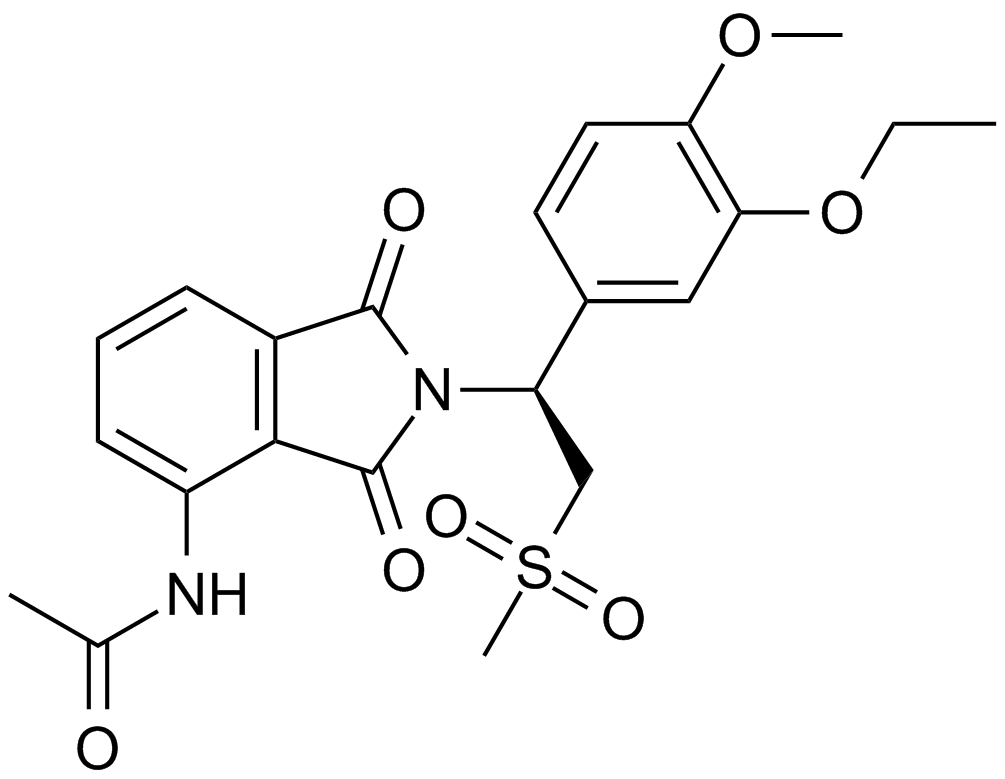Apremilast (CC-10004) (Synonyms: APR, CC-10004) |
| カタログ番号GC10420 |
経口投与可能なPDE4阻害剤
Products are for research use only. Not for human use. We do not sell to patients.

Cas No.: 608141-41-9
Sample solution is provided at 25 µL, 10mM.
Apremilast, also known as CC-10004, is a novel and potent small-molecule inhibitor of phosphodiesterase 4 (PDE4), a key enzyme involved in cyclic adenosine monophosphate (cAMP) degradation and cytokine production of inflammatory cells. Apremilast binds to the catalytic site of PDE4, with values of inhibition constant IC50 and affinity constant Kiof 0.074 μM and 68 nM respectively, consequently leading to the degradation of cAMP. Apremilast exhibits anti-inflammatory activities against inflammatory disease in animal models as well as human chronic inflammatory diseases (such as psoriasis and psoriatic arthritis) by blocking the synthesis of a range of pro-flammatory cytokines and chemokines, including tumor necrosis factor alpha, interleukin 23, CXCL9 and CXCL10.
Reference
[1].Georg Schett, Victor S. Sloan, Randall M. Stevens and Peter Schafer. Apremilast: a novel PDE4 inhibitor in the treatment of autoimmune and inflammatory disease. Ther Adv Musculoskelet Dis. 2010; 2(5): 271-278
| Cell experiment [1]: | |
|
Cell lines |
U937 human monocytic cells |
|
Preparation method |
The solubility of this compound in DMSO is >10 mM. General tips for obtaining a higher concentration: Please warm the tube at 37 °C for 10 minutes and/or shake it in the ultrasonic bath for a while.Stock solution can be stored below -20°C for several months. |
|
Reaction Conditions |
18h; IC50=74 nM |
|
Applications |
Apremilast was initially screened for PDE4 inhibition using a partially purified enzyme preparation from U937 human monocytic cells and which has been shown previously to contain predominantly PDE4B and PDE4D activities. Apremilast was also found to exhibit an IC50 of around 74 nM using 1 mM cAMP as substrate. |
| Animal experiment [1]: | |
|
Animal models |
SCID mice |
|
Dosage form |
5 mg·kg-1·day-1 ; oral taken |
|
Applications |
The pharmacological activity of apremilast (5 mg·kg-1·day-1 total divided into 2 daily doses) was tested in comparison with cyclosporine (5 mg·kg-1·day-1 total divided into 2 daily doses) and vehicle control (0.1 mL·day-1 divided into twice daily doses) in a mouse xenograft model of psoriasis. Epidermal thickness and proliferation index correlated with histological findings and demonstrated significant differences between treatment groups. Notably, apremilast caused statistically significant reductions in epidermal thickness (P < 0.001) and proliferation index (P < 0.001). |
|
Other notes |
Please test the solubility of all compounds indoor, and the actual solubility may slightly differ with the theoretical value. This is caused by an experimental system error and it is normal. |
|
References: [1] Schafer P H, Parton A, Gandhi A K, et al. Apremilast, a cAMP phosphodiesterase‐4 inhibitor, demonstrates anti‐inflammatory activity in vitro and in a model of psoriasis[J]. British journal of pharmacology, 2010, 159(4): 842-855. | |
| Cas No. | 608141-41-9 | SDF | |
| 同義語 | APR, CC-10004 | ||
| Chemical Name | N-[2-[(1S)-1-(3-ethoxy-4-methoxyphenyl)-2-methylsulfonylethyl]-1,3-dioxoisoindol-4-yl]acetamide | ||
| Canonical SMILES | CCOC1=C(C=CC(=C1)C(CS(=O)(=O)C)N2C(=O)C3=C(C2=O)C(=CC=C3)NC(=O)C)OC | ||
| Formula | C22H24N2O7S | M.Wt | 460.5 |
| 溶解度 | ≥ 23.05 mg/mL in DMSO | Storage | Store at -20°C |
| General tips | Please select the appropriate solvent to prepare the stock solution according to the
solubility of the product in different solvents; once the solution is prepared, please store it in
separate packages to avoid product failure caused by repeated freezing and thawing.Storage method
and period of the stock solution: When stored at -80°C, please use it within 6 months; when stored
at -20°C, please use it within 1 month. To increase solubility, heat the tube to 37°C and then oscillate in an ultrasonic bath for some time. |
||
| Shipping Condition | Evaluation sample solution: shipped with blue ice. All other sizes available: with RT, or with Blue Ice upon request. | ||
| Prepare stock solution | |||

|
1 mg | 5 mg | 10 mg |
| 1 mM | 2.1716 mL | 10.8578 mL | 21.7155 mL |
| 5 mM | 0.4343 mL | 2.1716 mL | 4.3431 mL |
| 10 mM | 0.2172 mL | 1.0858 mL | 2.1716 mL |
Step 1: Enter information below (Recommended: An additional animal making an allowance for loss during the experiment)
 g
g
 μL
μL

Step 2: Enter the in vivo formulation (This is only the calculator, not formulation. Please contact us first if there is no in vivo formulation at the solubility Section.)
Calculation results:
Working concentration: mg/ml;
Method for preparing DMSO master liquid: mg drug pre-dissolved in μL DMSO ( Master liquid concentration mg/mL, Please contact us first if the concentration exceeds the DMSO solubility of the batch of drug. )
Method for preparing in vivo formulation: Take μL DMSO master liquid, next addμL PEG300, mix and clarify, next addμL Tween 80, mix and clarify, next add μL ddH2O, mix and clarify.
Method for preparing in vivo formulation: Take μL DMSO master liquid, next add μL Corn oil, mix and clarify.
Note: 1. Please make sure the liquid is clear before adding the next solvent.
2. Be sure to add the solvent(s) in order. You must ensure that the solution obtained, in the previous addition, is a clear solution before proceeding to add the next solvent. Physical methods such as vortex, ultrasound or hot water bath can be used to aid dissolving.
3. All of the above co-solvents are available for purchase on the GlpBio website.
Quality Control & SDS
- View current batch:
- Purity: >99.50%
- COA (Certificate Of Analysis)
- SDS (Safety Data Sheet)
- Datasheet
Average Rating: 5 (Based on Reviews and 30 reference(s) in Google Scholar.)
GLPBIO products are for RESEARCH USE ONLY. Please make sure your review or question is research based.
Required fields are marked with *



















